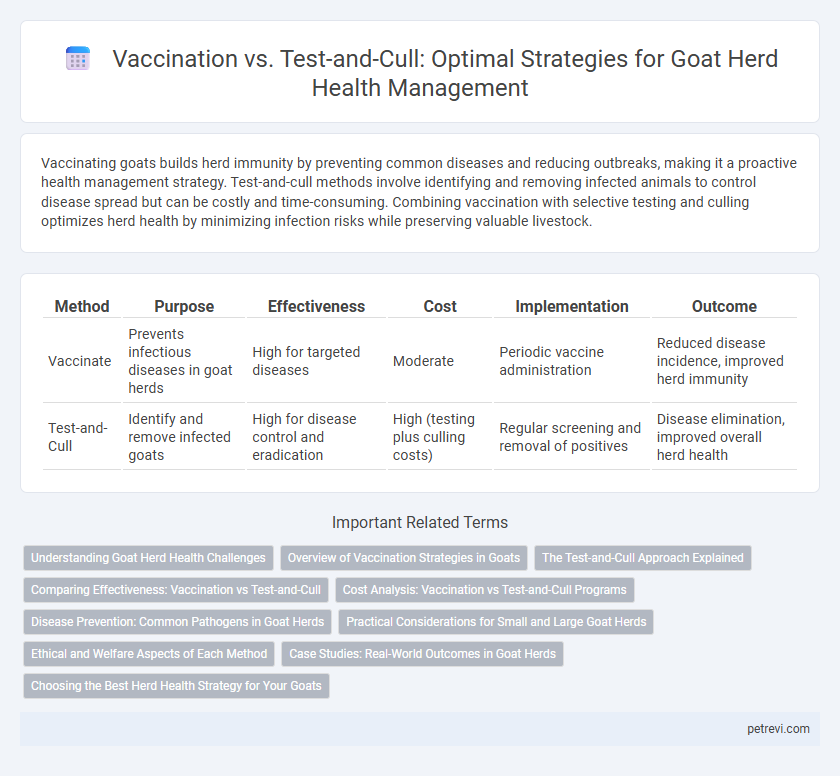Vaccinating goats builds herd immunity by preventing common diseases and reducing outbreaks, making it a proactive health management strategy. Test-and-cull methods involve identifying and removing infected animals to control disease spread but can be costly and time-consuming. Combining vaccination with selective testing and culling optimizes herd health by minimizing infection risks while preserving valuable livestock.
Table of Comparison
| Method | Purpose | Effectiveness | Cost | Implementation | Outcome |
|---|---|---|---|---|---|
| Vaccinate | Prevents infectious diseases in goat herds | High for targeted diseases | Moderate | Periodic vaccine administration | Reduced disease incidence, improved herd immunity |
| Test-and-Cull | Identify and remove infected goats | High for disease control and eradication | High (testing plus culling costs) | Regular screening and removal of positives | Disease elimination, improved overall herd health |
Understanding Goat Herd Health Challenges
Vaccinating goats provides proactive immunity against common diseases like clostridial infections, reducing overall morbidity and mortality rates within the herd. Test-and-cull strategies focus on identifying and removing infected animals to prevent disease spread, primarily effective against contagious diseases such as caprine arthritis encephalitis (CAE) and Johne's disease. Balancing vaccination programs with targeted test-and-cull approaches optimizes herd health management by minimizing disease prevalence and improving long-term productivity.
Overview of Vaccination Strategies in Goats
Vaccination strategies in goats primarily target common infectious diseases like caprine arthritis encephalitis, caseous lymphadenitis, and contagious ecthyma, aiming to enhance herd immunity and reduce mortality rates. Effective vaccines stimulate specific antibody responses that decrease pathogen transmission within the herd, providing long-term protection compared to the reactive nature of test-and-cull methods. Herd health programs incorporating regular vaccination schedules demonstrate a significant decline in disease outbreaks and improve overall productivity by minimizing economic losses linked to infectious diseases.
The Test-and-Cull Approach Explained
The test-and-cull approach for goat herd health involves regular diagnostic testing to identify infected animals, followed by the immediate removal of those testing positive to prevent disease spread. This method is effective in controlling contagious diseases such as caprine arthritis encephalitis (CAE) and Johne's disease by reducing pathogen reservoirs within the herd. Consistent application of test-and-cull protocols can lead to significant improvement in overall herd health and productivity over time.
Comparing Effectiveness: Vaccination vs Test-and-Cull
Vaccination in goat herds significantly reduces the incidence of infectious diseases by enhancing immunity and preventing outbreaks, making it a proactive approach to herd health management. Test-and-cull strategies identify and remove infected animals, effectively reducing disease prevalence but can be costly and labor-intensive due to continuous testing requirements. Studies show vaccination offers long-term herd immunity and cost-efficiency, while test-and-cull provides immediate disease control, highlighting the importance of selecting a method based on disease type and herd management goals.
Cost Analysis: Vaccination vs Test-and-Cull Programs
Vaccination programs for goat herds generally incur lower upfront costs compared to test-and-cull strategies, which involve continuous testing and removal of infected animals, leading to higher labor and replacement expenses. Over time, vaccination reduces disease prevalence, minimizing productivity losses and veterinary interventions, whereas test-and-cull requires ongoing investment in diagnostics and herd management. Economic analyses indicate that vaccination provides a more cost-effective solution for maintaining herd health and ensuring sustainable goat production.
Disease Prevention: Common Pathogens in Goat Herds
Vaccination effectively prevents common goat diseases such as Caseous Lymphadenitis, Clostridial infections, and Caprine Arthritis Encephalitis by stimulating immunity before exposure. Test-and-cull strategies target chronic infections like Johne's disease and Caprine Arthritis Encephalitis by identifying and removing infected individuals to reduce pathogen spread. Combining vaccination with regular testing optimizes herd health management by minimizing disease prevalence and enhancing overall herd immunity.
Practical Considerations for Small and Large Goat Herds
Vaccinate protocols for goat herds reduce the incidence of infectious diseases and are cost-effective for large herds by minimizing labor and repeated testing. Test-and-cull strategies require intensive individual animal monitoring and are more practical for small herds to quickly eliminate infected goats and prevent disease spread. Herd size influences the choice of disease control: vaccination suits extensive operations, while test-and-cull is feasible for smaller herds with manageable animal populations.
Ethical and Welfare Aspects of Each Method
Vaccinating goats enhances herd immunity with minimal stress, reducing disease prevalence without removing animals from the population, thus supporting ethical standards in animal welfare. Test-and-cull methods may quickly eliminate infected individuals but often result in ethical concerns due to the culling of potentially healthy goats and the psychological impact on the herd. Prioritizing vaccination aligns with welfare principles by promoting natural disease resistance and minimizing harm, while test-and-cull demands careful consideration of the balance between effective disease control and animal well-being.
Case Studies: Real-World Outcomes in Goat Herds
Vaccinate programs in goat herds have demonstrated significant reductions in disease prevalence, with case studies showing up to a 70% decrease in infection rates compared to test-and-cull methods. Test-and-cull strategies often result in slower herd health improvements and higher economic losses due to the removal of valuable animals without guaranteed disease eradication. Real-world outcomes highlight vaccination as a more sustainable and cost-effective approach to controlling infectious diseases in goat populations.
Choosing the Best Herd Health Strategy for Your Goats
Vaccinating goats against infectious diseases like Caprine Arthritis Encephalitis (CAE) and Johne's disease provides proactive protection, reducing morbidity and mortality rates within the herd. Test-and-cull strategies rely on periodic diagnostic testing to identify and remove infected individuals, effectively minimizing disease spread but potentially reducing herd size and productivity. Selecting the best herd health strategy depends on factors such as disease prevalence, economic resources, herd size, and management practices to optimize overall goat herd health and profitability.
Vaccinate vs Test-and-cull for Goat herd health Infographic

 petrevi.com
petrevi.com